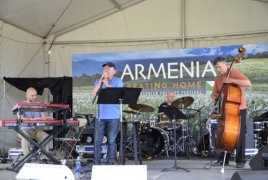
Armenia was one of two featured countries at the Smithsonian Folklife Festival last week in Washington D.C., and members of Los Angeles's own strong Armenian community were among those celebrating their rich musical heritage, LAist reports.
It was so, so humid at the festival. Singer Samvel Galstian and his group performed a set of Armenian folk songs in a jazz setting.
Vardan Ovsepian — an Armenian-American pianist based in L.A. who played with the group — said it may be surprising, but Armenian and American music have a lot in common.
"Armenians grew-up with lots of different odd meters and syncopations, which coincides with jazz a lot," Ovsepian said. "Also the improvisational element too. ... Some of the Armenian traditional music is not all rigid and written, there's lots of improvisation, so that aspect also is very similar to jazz."
Galstian says jazz has been a popular style in Armenia since the early 1950s. His new album features traditional Armenian songs from the 1940s to the '70s.
"So these are very well-known songs in Armenia. So the Armenian music element is in there, even if I sing as a jazz, as contemporary jazz, it's still there, the flavor of Armenian words and music."
Zulal, a female trio that sings Armenian folk a cappella, also performed at the festival. The band includes singers Teni Apelian, Yeraz Markarian, and Anaïs Tekerian. Tekerian says that when they met in New York City 15 years ago, they discovered they all had a cappella backgrounds.
"Teni had a background in a cappella jazz and Yeraz in more pop-rock, and for me it was more Slavic, college a cappella, and [we] decided to put together a group — since we were all at least half if not fully Armenian — put together a group and concentrate on Armenian music," Tekerian said.
Singer Teni Apelian says a cappella singing doesn't exist in Armenian folk music. Harmony was introduced to Armenia by the renowned musician, composer, and ethnomusicologist Komitas at the turn of the twentieth century.
"The harmony that we bring is very much Western-influenced, although there's a bit of Balkan influence coming from Anaïs' background, so it's a mix," Apelian said. "But I think our presentation has that in mind: to move this music into an arena that it can be sort of 'digested' by a wider audience."
The concept of interpreting Armenian folk songs with an American music style also inspired an L.A. pop trio. On a recent Tuesday afternoon at a restaurant in Little Armenia near Hollywood, guitarist Mher Ajamian explained how his group Armenian Public Radio (love the shoutout, you public radio fans you) interpret traditional songs.
"In a style that is more congruent with the country that we grew up in, the U.S. — a lot of Americana, blues and folk, American folk influence in our music," Ajamian said.
Ajamian, 37, says one of the reasons they decided to interpret traditional songs stems from the trio's efforts to get more Armenians to listen to their own folk music.
"None of our friends and our contemporaries really actively listen to traditional Armenian folk music, so we wanted to make it more accessible to them," Ajamian said.
The common denominator among Armenian-American musicians is traditional music, Anaïs Tekerian from Zulal said.
"The thing that ties us together is Armenian folk itself. Really, you can't be an Armenian who doesn't know at least some of the, a good number, at least a dozen of the songs that just everyone knows," Tekerian said. "So it's very easy for us to pull on that and to create our own version of Armenian folk jazz, Armenian folk a cappella, or whatever. I think that's what connects us, that basic canon that we all have."

